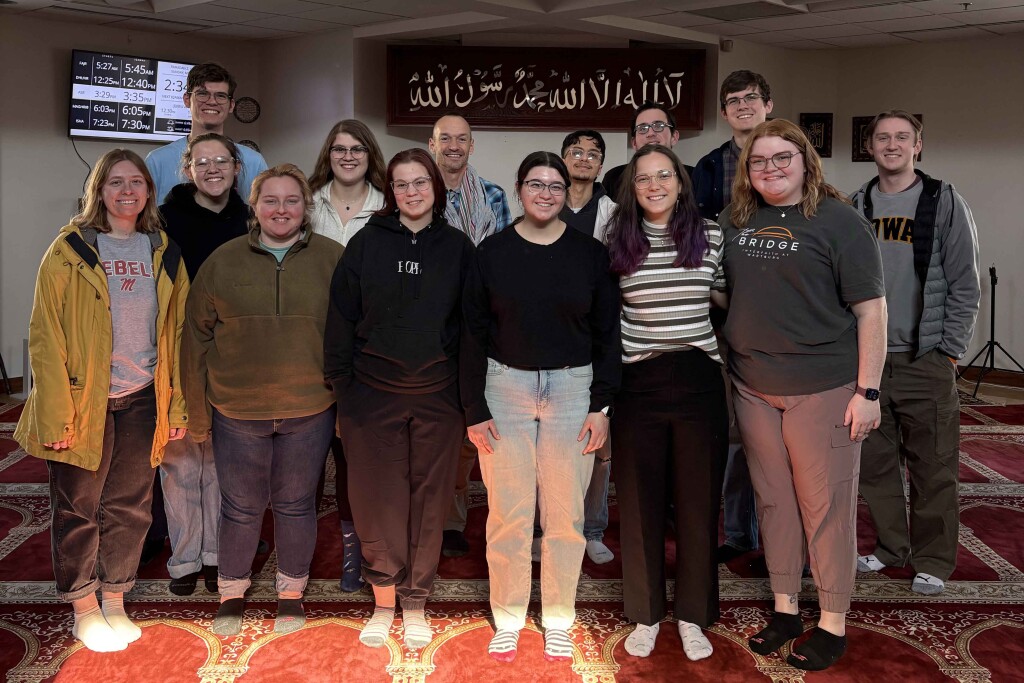Bridging the divide
July 31, 2025

Interfaith initiative leads to better communication among students
Wartburg may be a college of the Evangelical Lutheran Church in America, but fewer than 200 of the school’s 1,400 students are affiliated with the church. For Chaplain Maggie Falenschek, dean of spiritual life and the Herbert and Cora Moehlmann Chaplaincy Chair, this means pastoring to students on campus isn’t as easy as leading weekly worship services.
“In my first year at Wartburg, I did a lot of deep listening and one-on-ones with students to see how well we accommodate religious diversity and the campus’s base knowledge of religious differences,” said Falenschek, who joined the college in 2023. “What I discovered is that we needed to do more to increase religious literacy for all students as well as provide opportunities for students to engage across differences.”
While the majority of Wartburg students report practicing a Christian faith, the college also is home to students from Islamic, Jewish, Hindu, and Buddhist traditions. Though individuals of all faiths have always been welcomed in the Chapel and at Spiritual Life & Campus Ministry events, Falenschek said she wants to be more intentional about the efforts.
During the 2024-25 school year, this meant inviting students to live in an interfaith suite where individuals from varying faith backgrounds could get to know each other on a deeper level. The goal was simple yet transformative: to create a campus culture where students of all backgrounds feel welcome practicing their faith — and talking about it with one another.
“The students would tell me about the amazing conversations they would have in their living room at like 11 p.m. about the things that they value or the ways they want to continue this movement across campus,” Falenschek said. “When you are living and sharing meals with someone, you get to know them better as a human, and that is fundamental in interfaith work.”
The suitemates represented varying religions — Protestant, Lutheran, Methodist, nondenominational, and agnostic but grew up Muslim — but were able to find common ground, or at least understanding, on typically polarizing topics.
“Most of our serious discussions stemmed from topics that could have very easily turned into an argument, but we were able to say, ‘OK, why do you believe that,’ and have the conversation with an open mind,” said Holden Willrett ’27, a biology major from Mason City. “At the end of the conversation, we could walk away still being friends and maybe even stronger friends than before because we shared respect for each other.”
Those conversations also helped the residents in their day-to-day conversations with others.
“It was almost as if we had beta versions of those hard conversations with our roommates, so when we were with others, we had already processed our initial reactions and thought about the implications from varying viewpoints,” said Jack Willrett ’27, Holden’s twin and a religion major who plans to attend seminary following graduation. Alexa Brockmueller ’27, a psychology and social work major from Sioux Falls, S.D., didn’t live in the suite but was one of several students to join Falenschek and the suitemates on an interfaith immersion experience in the Twin Cities during Winter Break (pictured above). Participants joined a Ramadan Iftar dinner, observed a sabbath worship at a Jewish temple, and toured a Hindu temple.
The group also partnered with Interfaith Power & Light, an organization that engages faith communities in environmental justice work. They visited George Floyd Square (pictured below), where they learned what different religious communities are doing to work for racial justice and served in a food pantry.
“Differences can be scary sometimes, but during these experiences the similarities in our religions were stressed so often, it was easy to connect with people on a deeper level,” Brockmueller said. “I didn’t know their whole life, but I could understand who they are because of how they practiced their religion. It was great to see relationships and communities thrive because of interfaith connections.”
